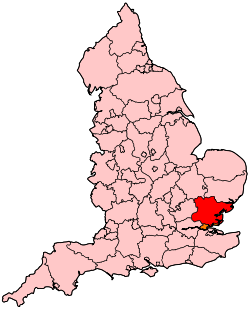Essex dialect

The Essex dialect is a rapidly disappearing dialect similar to some forms of East Anglian English and is now mainly confined to the north and the east of Essex. It shares vast similarities with both Suffolk and Norfolk dialects, with its own peculiarities. With rapid urbanisation in the 20th century as well as the impact of the London overspill, Estuary English, a milder form of the London accent predominant largely along the Thames Estuary and thus the name, has become common, mainly in the southern portion of the county. As a result of the growing London influence, the usage of rural accents everywhere and the rural Essex dialect is now normally, but not always, confined to older generations in some of the areas affected and the dialect itself stands in a vulnerable state in those affected parts of the county. Elsewhere in Essex, the dialect and rural accent continues.
For example, in the coastal town of Harwich the Essex dialect is still common, even among the town's youth, and is a defining feature of the area. Harwich is pronounced as "arridge" in the local dialect and in Manningtree which is very nearby they pronounce Manningtree "mannintree" dropping the g.
Many of the unique patterns of speech, as well as vocabulary were recorded in the nineteenth and early twentieth centuries[1][2] The Survey of English Dialects investigated 14 sites in Essex, most of which were in the rural north of the county. This unusually high number was the result of adding the five sites that were originally investigated to nine sites investigated by a Fulbright scholar after the original survey.[3]
An Essex Dialect Handbook has been published,[4] however recently, the Essex County Records office have recorded a CD of the sounds of Essex dialect speakers in an effort to preserve the dialect.[5][6]
Pronunciation
- The diphthong of [aɪ] which is common amongst East Anglian English and other predominantly English rural dialects, e.g. right > ‘roight’
- The shortening of certain elongated vowel sounds from [iː] to [ɪ], e.g. been > ‘bin’, seen > ‘sin’
- Yod-dropping is common, as in the Norfolk and Suffolk dialects
- Dropping of Ls, e.g. old > ‘owd’
Characteristics
Frequently sounds are elided to allow the easy flow of speech; e.g.,
- Wonderful > ‘wunnerful’
- Correctly > ‘creckly’
- St Osyth > ‘Toosie’ (*meaning 'To Saint', as in the place, Saint Osyth*)
Grammar
Varying use of ‘do’ which is a common trait in Norfolk and Suffolk are exhibited in the Essex dialect.